Impact Fracture Surfaces as the Indicators of Structural Steel Post-Fire Susceptibility to Brittle Cracking
Abstract
1. Introduction
2. Preparation of Samples
3. Description of the Impact Strength Tests Conducted
4. Parameters of the Observed Impact Fractures Used to Draw Conclusions
5. Microstructural Studies of Impact Fractures
6. Detailed Results of the Tests Conducted and Their Interpretation
6.1. Results Obtained on Samples Made of S355J2+N Steel
6.2. Results Obtained on Samples Made of X20Cr13 Steel
6.3. Results Obtained on Samples Made of X6CrNiTi18-10 Steel
6.4. Results Obtained on Samples Made of X2CrNiMoN22-5-3 Steel
7. Concluding Remarks
Author Contributions
Funding
Institutional Review Board Statement
Informed Consent Statement
Data Availability Statement
Conflicts of Interest
References
- Hahn, G.T. The influence of microstructure on brittle fracture toughness. Metall. Trans. A 1984, 15A, 947–959. [Google Scholar] [CrossRef]
- Bednarek, Z.; Kamocka, R. The heating rate impact on parameters characteristic of steel behaviour under fire conditions. J. Civ. Eng. Manag. 2006, 12, 269–275. [Google Scholar] [CrossRef]
- Maslak, M.; Zwirski, G. Changes in structural steel microstructures following heating and cooling episodes in fires. Saf. Fire Tech. 2017, 48, 34–52. [Google Scholar] [CrossRef]
- Maslak, M. Tests of structural steel after a fire in the context of assessing the possibility of its further use in the load-bearing members of building structures. Przegląd Bud. 2012, 6, 48–51. (In Polish) [Google Scholar]
- Peng, P.C.; Chi, J.H.; Cheng, J.W. A study on behavior of steel structures subjected to fire using non-destructive testing. Constr. Build. Mater. 2016, 128, 170–175. [Google Scholar] [CrossRef]
- Maslak, M.; Pazdanowski, M.; Stankiewicz, M.; Zajdel, P. The impact strength of selected steel types after fire. Experimental tests related to simulated fire conditions. In Proceedings of the 7th International Conference “Applications of Structural Fire Engineering” (ASFE), Online, 10–11 June 2021. [Google Scholar]
- Maslak, M.; Pazdanowski, M.; Stankiewicz, M.; Zajdel, P. Post-fire susceptibility to brittle fracture of selected steel grades used in construction industry—Assessment based on the instrumented impact test. Materials 2021, 14, 3922. [Google Scholar] [CrossRef]
- Pancikiewicz, K.; Maslak, M.; Pazdanowski, M.; Stankiewicz, M.; Zajdel, P. Changes in the microstructure of selected structural alloy steel grades identified after their simulated exposure to fire temperature. Case Stud. Constr. Mater. 2023, 18, e01923. [Google Scholar] [CrossRef]
- Server, W.L. Instrumented Charpy test review and application to structural integrity. In From Charpy to Present Impact Testing; François, D., Pineau, A., Eds.; Elsevier Science and ESIS: Amsterdam, The Netherlands, 2002; pp. 205–212. [Google Scholar] [CrossRef]
- Alar, Ž.; Mandić, D.; Dugorepec, A.; Sakoman, M. Application of instrumented Charpy method in characterization of materials. Interdiscip. Descr. Complex Syst. 2015, 13, 479–487. [Google Scholar] [CrossRef]
- Pereira, L.C.; Garcia de Blas, J.C.; Griza, S.; Darwish, F.A.I. Use of instrumented Charpy testing on the fracture toughness characterization of metallic materials. Tecnol. Em Metal. Mater. E Min. 2021, 18, e2469. [Google Scholar] [CrossRef]
- Ali, M.B.; Abdullah, S.; Nuawi, M.Z.; Padzi, M.M.; Zakaria, K.A. Experimental analysis of an instrumented Charpy impact using statistical study based data analysis. Int. J. Mech. Mater. Eng. (IJMME) 2011, 6, 260–268. [Google Scholar]
- Zajdel, P. A suitability assessment using an instrumented impact test of the use of selected structural steel grades on the basis of their changes in response to exposure to fire. Tech. Trans. 2021, 118, e2021007. [Google Scholar] [CrossRef]
- EN-ISO 148-1; Metallic Materials—Charpy Pendulum Impact Test. Part 1: Test Method. ISO: Geneva, Switzerland, 2006.
- EN-ISO 14556; Metallic Materials—Charpy V-Notch Pendulum Impact Test. Instrumented Test Method. ISO: Geneva, Switzerland, 2015.
- ASTM E 2298-18; Standard Test Method for Instrumented Impact Testing of Metallic Materials. American Society for Testing and Materials: West Conshohocken, PA, USA, 2018. [CrossRef]
- ASTM E 23-92; Standard Test Methods for Notched Bar Impact Testing of Metallic Materials. American Society for Testing and Materials: West Conshohocken, PA, USA, 2016. [CrossRef]
- Schmitt, W.; Varflomeyev, I.; Böhme, W. Modelling of the Charpy test as a basis for toughness evaluation. In From Charpy to Present Impact Testing; François, D., Pineau, A., Eds.; Elsevier Science and ESIS: Amsterdam, The Netherlands, 2002; pp. 45–56. [Google Scholar] [CrossRef]
- Balyts’kyi, O.I.; Ripei, I.V.; Protsakh, K.A. Reliability of steam pipelines of thermal power plants in the course of long-term operation. Mater. Sci. 2006, 42, 461–465. [Google Scholar] [CrossRef]
- Tronskar, J.P.; Mannan, M.A.; Lai, M.O. Measurement of fracture initiation toughness and crack resistance in instrumented Charpy impact testing. Eng. Fract. Mech. 2002, 69, 321–338. [Google Scholar] [CrossRef]
- Kharchenko, V.V.; Kondryakov, E.A.; Zhamaka, V.N.; Babutskii, A.A.; Babutskii, A.I. The effect of temperature and loading rate on the crack initiation and propagation energy in carbon steel Charpy specimens. Strength Mater. 2006, 38, 535–541. [Google Scholar] [CrossRef]
- Müller, K.; Push, G. Use of Charpy impact testing to evaluate crack arrest fracture toughness. In From Charpy to Present Impact Testing; François, D., Pineau, A., Eds.; Elsevier Science and ESIS: Amsterdam, The Netherlands, 2002; pp. 263–270. [Google Scholar] [CrossRef]
- François, D. Micromechanisms and the Charpy transition curve. In From Charpy to Present Impact Testing; François, D., Pineau, A., Eds.; Elsevier Science and ESIS: Amsterdam, The Netherlands, 2002; pp. 21–31. [Google Scholar] [CrossRef]
- Cubides-Herrera, C.S.; Villba-Rondón, D.A.; Rodríguez-Baracaldo, R. Charpy impact toughness and transition temperature in ferrite–pearlite steel. Sci. Et Tech. 2019, 24, 200–204. [Google Scholar]
- Mengqi, Z.; Shanwu, Y.; Farong, W. Competition mechanism of brittle–ductile transition of metals under tensile condition. Mech. Mater. 2019, 137, 103138. [Google Scholar] [CrossRef]
- Curry, D.; Knott, J.F. Effect of microstructure on cleavage fracture stress in steel. Met. Sci. 1978, 12, 511–514. [Google Scholar] [CrossRef]
- Chen, L.; Liu, W.; Yu, L.; Cheng, Y.; Ren, K.; Sui, H.; Yi, X.; Duan, H. Probabilistic and constitutive models for ductile-to-brittle transition in steels: A competition between cleavage and ductile fracture. J. Mech. Phys. Solids 2020, 135, 103809. [Google Scholar] [CrossRef]
- Lin, T.; Evans, A.G.; Ritchie, R.O. Stochastic modeling of the independent roles of particle size and grain size in transgranular cleavage fracture. Metall. Trans. A 1987, 18, 641–651. [Google Scholar] [CrossRef]
- MacKenzie, S. Overview of the mechanisms of failure in heat treated steel components. In Failure Analysis of Heat Treated Steel Components; Canale, L.C.F., Mesquita, R.A., Totten, G.E., Eds.; ASM Technical Books; ASM International: Materials Park, OH, USA, 2008. [Google Scholar] [CrossRef]
- Mirmomeni, M.; Heidarpour, A.; Xiao-Ling Zhao Hutchinson, C.R.; Packer, J.A.; Chengqing, W. Fracture behaviour and microstructural evolution of structural mild steel under the multi-hazard loading of high-strain-rate load followed by elevated temperature. Constr. Build. Mater. 2016, 122, 760–771. [Google Scholar] [CrossRef]
- Pantazopoulos, G.A. A short review on fracture mechanisms of mechanical components operated under industrial process conditions: Fractographic analysis and selected prevention strategies. Metals 2019, 9, 148. [Google Scholar] [CrossRef]
- Kai, Y.; Ozaki, F. Impact fracture energy of steel welded connections in fire and post-fire. J. Constr. Steel Res. 2020, 170, 106120. [Google Scholar] [CrossRef]
- Kai, Y.; Ozaki, F.; Knobloch, M. Impact fracture energies of cold-formed steel square hollow section in and after fire. J. Constr. Steel Res. 2021, 183, 106740. [Google Scholar] [CrossRef]
- Zhu, Y.; Huang, S.; Sajid, H.U. Micro-mechanisms and modelling of ductile fracture initiation in structural steel after exposure to elevated temperatures. Metals 2021, 11, 767. [Google Scholar] [CrossRef]
- Zhu, H.; Zhang, C.; Chen, S.; Wu, J. A modified Johnson-Cook constitutive model for structural steel after cooling from high temperature. Constr. Build. Mater. 2022, 340, 127746. [Google Scholar] [CrossRef]
- Dzioba, I.; Lipiec, S. Fracture mechanisms of S355 steel—Experimental research, FEM simulation and SEM observation. Materials 2019, 12, 3959. [Google Scholar] [CrossRef]
- Joo, M.S.; Suha, D.W.; Baec, J.H.; Bhadeshia, H.K.D.H. Role of delamination and crystallography on anisotropy of Charpy toughness in API-X80 steel. Mater. Sci. Eng. A 2012, 546, 314–322. [Google Scholar] [CrossRef]
- Kim, J.-S.; Kim, Y.-J.; Lee, M.-W.; Kim, K.-S.; Shibanuma, K. Fracture simulation model for API X80 Charpy test in ductile–brittle transition temperatures. Int. J. Mech. Sci. 2020, 182, 105771. [Google Scholar] [CrossRef]
- Kantor, M.; Vorkachev, K.; Bozhenov, V.; Solntsev, K. The role of splitting phenomenon under fracture of low-carbon microalloyed X80 pipeline steels during multiple Charpy impact tests. Appl. Mech. 2022, 3, 740–756. [Google Scholar] [CrossRef]
- Tong, L.; Niu, L.; Jing, S.; Ai, L.; Zhao, X.-L. Low temperature impact toughness of high strength structural steel. Thin-Walled Struct. 2018, 132, 410–420. [Google Scholar] [CrossRef]
- Samuel, K.G.; Sreenivasan, P.R.; Ray, S.K.; Rodriguez, P. Evaluating of ageing-induced embrittlement in an austenitic stainless steel by instrumented impact testing. J. Nucl. Mater. 1987, 150, 78–84. [Google Scholar] [CrossRef]
- Laukkanen, A.; Uusikallio, S.; Lindroos, M.; Andersson, T.; Kömi, J.; Porter, D. Micromechanics driven design of ferritic-austenitic duplex stainless steel microstructures for improved cleavage fracture toughness. Eng. Fract. Mech. 2021, 253, 107878. [Google Scholar] [CrossRef]
- Topolska, S.; Labanowski, J. Impact-toughness investigations of duplex stainless steels. Mater. Technol. 2015, 49, 481–486. [Google Scholar] [CrossRef]
- Sieurin, H. Fracture Toughness Properties of Duplex Stainless Steels. Ph.D. Thesis, Department of Materials Science and Engineering, Royal Institute of Technology, Stockholm, Sweden, 2006. [Google Scholar]
- NISTIR 8043; Determination of the Compliance of NIST Charpy Impact Machines. National Institute of Standard and Technology, U.S. Department of Commerce: Gaithersburg, MD, USA, 2015. [CrossRef]
- Klepaczko, J.R. Impact loading on specimens of different geometries, test methods and results. In Crack Dynamics in Metallic Materials; Klepaczko, J.R., Ed.; Springer: Wien, Austria, 1990; pp. 396–398. [Google Scholar] [CrossRef]
- Strnadel, B.; Matocha, K. Testing samples size effect on notch toughness of structural steels. Metalurgija 2009, 48, 253–256. [Google Scholar]
- Zajdel, P. Interpretation of the results of the impact test performed with an instrumented Charpy pendulum for the purposes of assessing the properties of structural steels. Inżynieria I Bud. 2020, 7, 341–344. (In Polish) [Google Scholar]
- Nanstad, R.K.; Sokolov, M.A. Charpy impact test results on five materials and NIST verification specimens using instrumented 2-mm and 8-mm strikers. In Pendulum Impact Machines. Procedures and Specimens for Verification; Siewert, T.A., Schmieder, A.K., Eds.; ASTM STP 1248; ASTM: West Conshohocken, PA, USA, 1995; pp. 111–139. [Google Scholar]
- van Walle, E. Evaluating material properties by dynamic testing. In ESIS Publication 20; Mechanical Engineering Publications Limited: Suffolk, UK, 1996. [Google Scholar]
- Sreenivasan, R. Charpy energy–lateral expansion relations for a wide range of steels. Int. J. Press. Vessel. Pip. 2006, 83, 498–504. [Google Scholar] [CrossRef]
- Stankiewicz, M.; Holloway, G.; Marshall, A.; Zhang, Z.; Slazak, B. Charpy impact test and lateral expansion parameter in welding consumables evaluation for cryogenic application. Przegląd Spaw. 2012, 11, 2–11. (In Polish) [Google Scholar]
- Wang, C.; Tong, Z.; Zhong, W.; Lin, H.; Ning, G.; Zhang, C.; Yu, B.; Xu, S.; Yang, W. A method for directly measuring fracture toughness and determining reference temperature for RPV steels by Charpy impact test. Eng. Fract. Mech. 2021, 243, 107526. [Google Scholar] [CrossRef]
- Park, T.C.; Kim, B.S.; Son, J.H.; Yeo, Y.K. A new fracture analysis technique for Charpy impact test using image processing. Korean J. Met. Mater. 2021, 59, 61–66. [Google Scholar] [CrossRef]
- Wouters, R.; Froyen, L. Scanning electron microscope fractography in failure analysis of steels. Mater. Charact. 1996, 36, 357–364. [Google Scholar] [CrossRef]
- Goldstein, J.; Newbury, D.; Joy, D.; Lyman, C.; Echlin, P.; Lifshin, E.; Sawyer, L.; Michael, J. Scanning Electron Microscopy and X-ray Microanalysis, 3rd ed.; Kluwer Academic Publishers: New York, NY, USA, 2003; pp. 1–673. [Google Scholar] [CrossRef]
- Wassilkowska, A.; Czaplicka-Kotas, A.; Zielina, M.; Bielski, A. An analysis of the elemental composition of micro-samples using EDS technique. Tech. Trans. Chem. 2014, 18, 133–148. [Google Scholar]
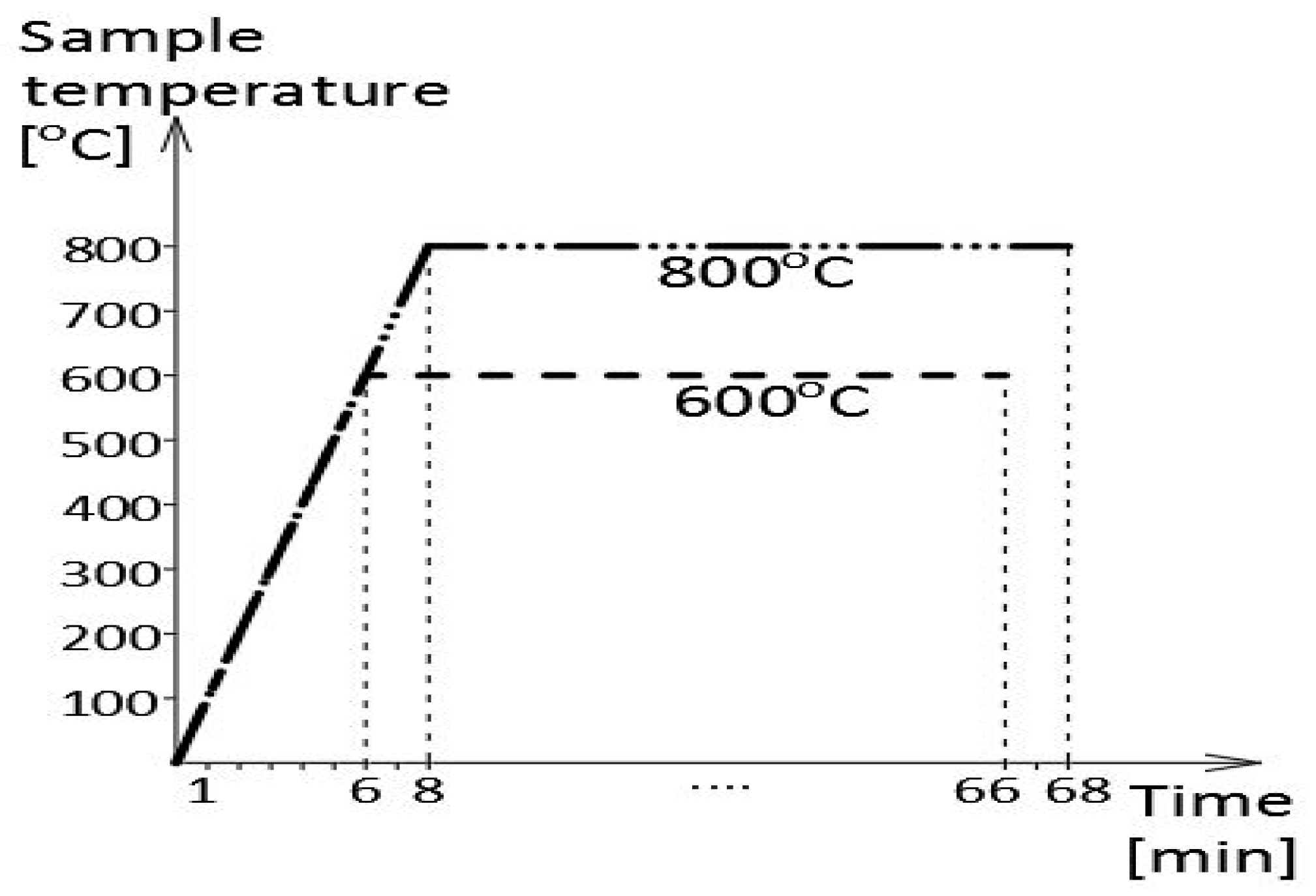

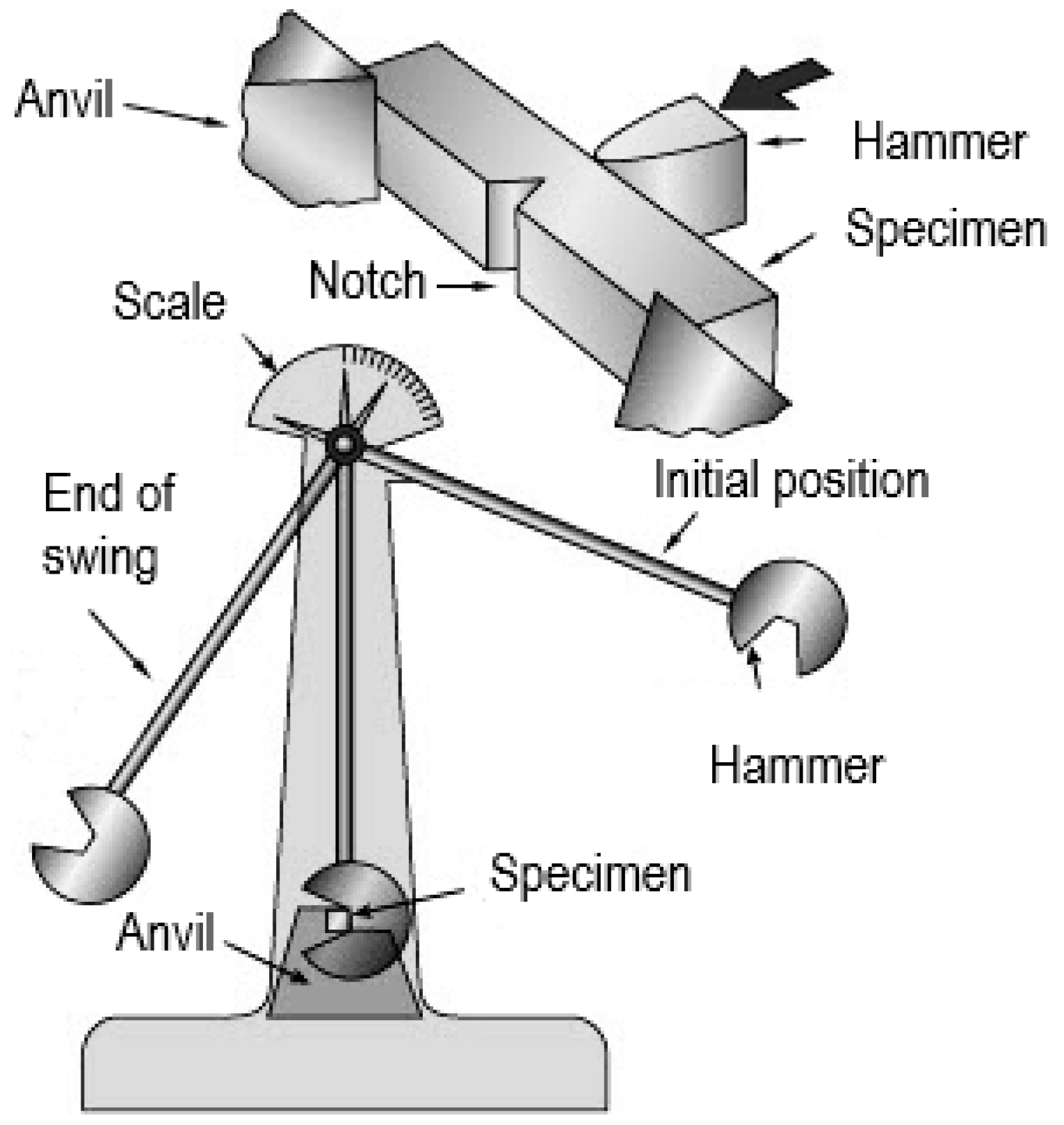
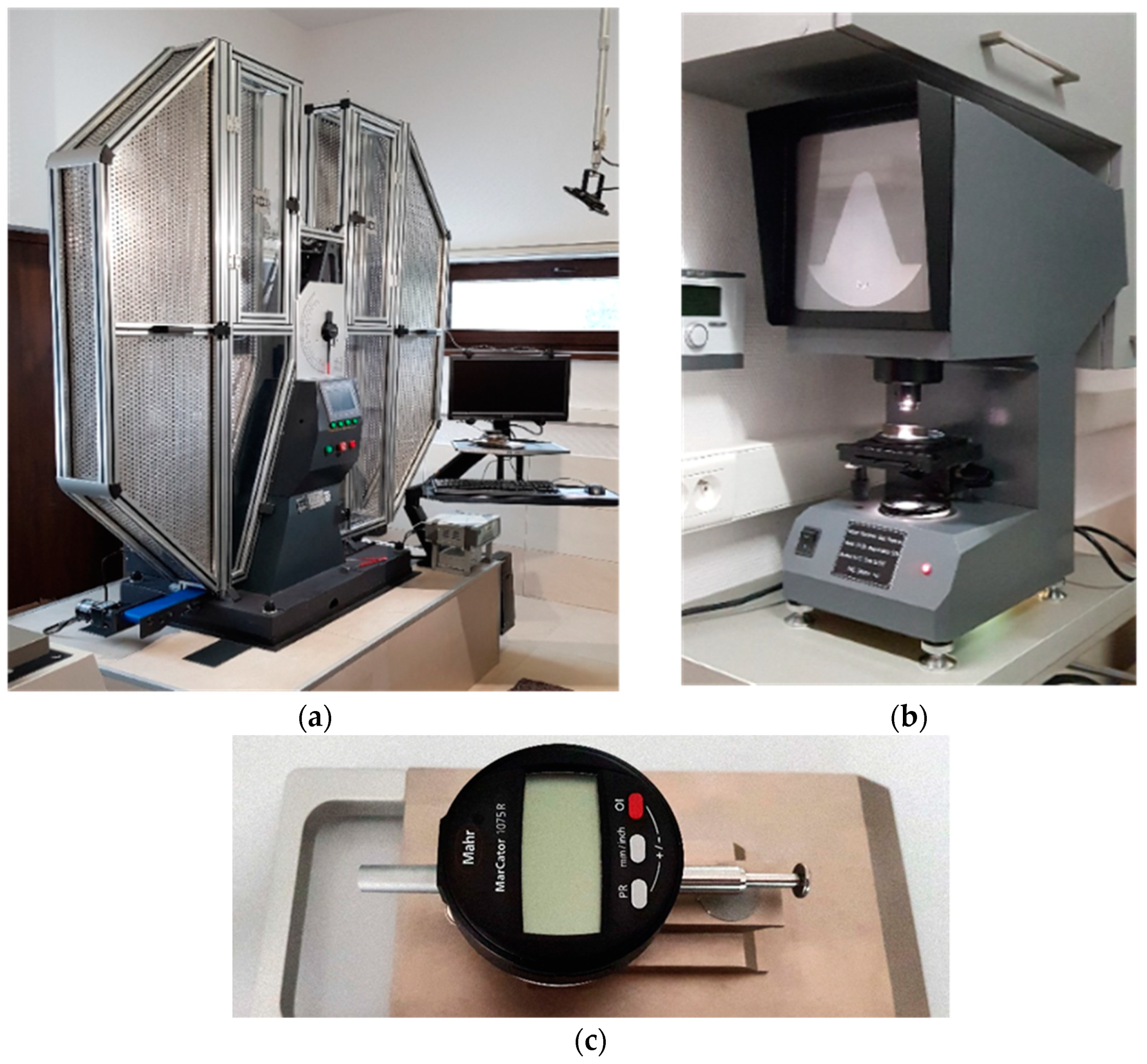



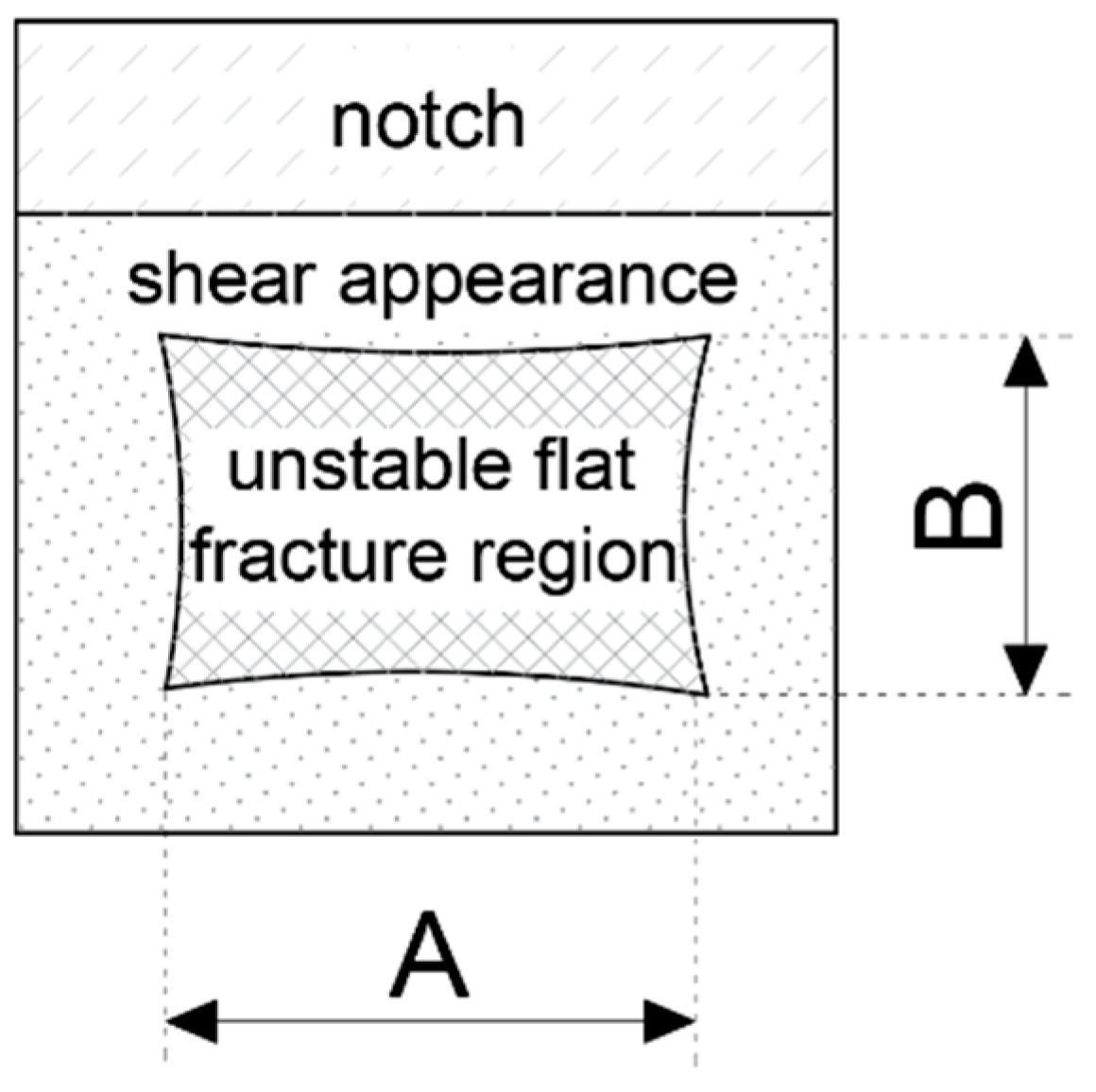
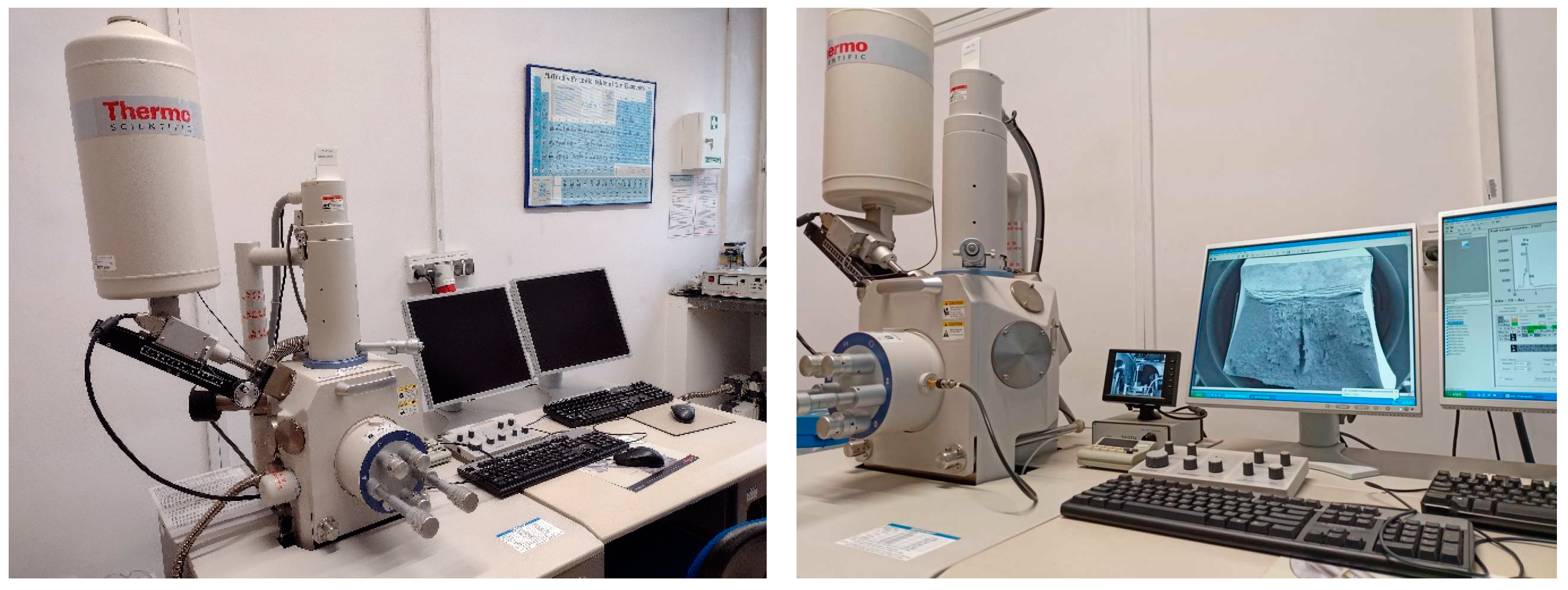

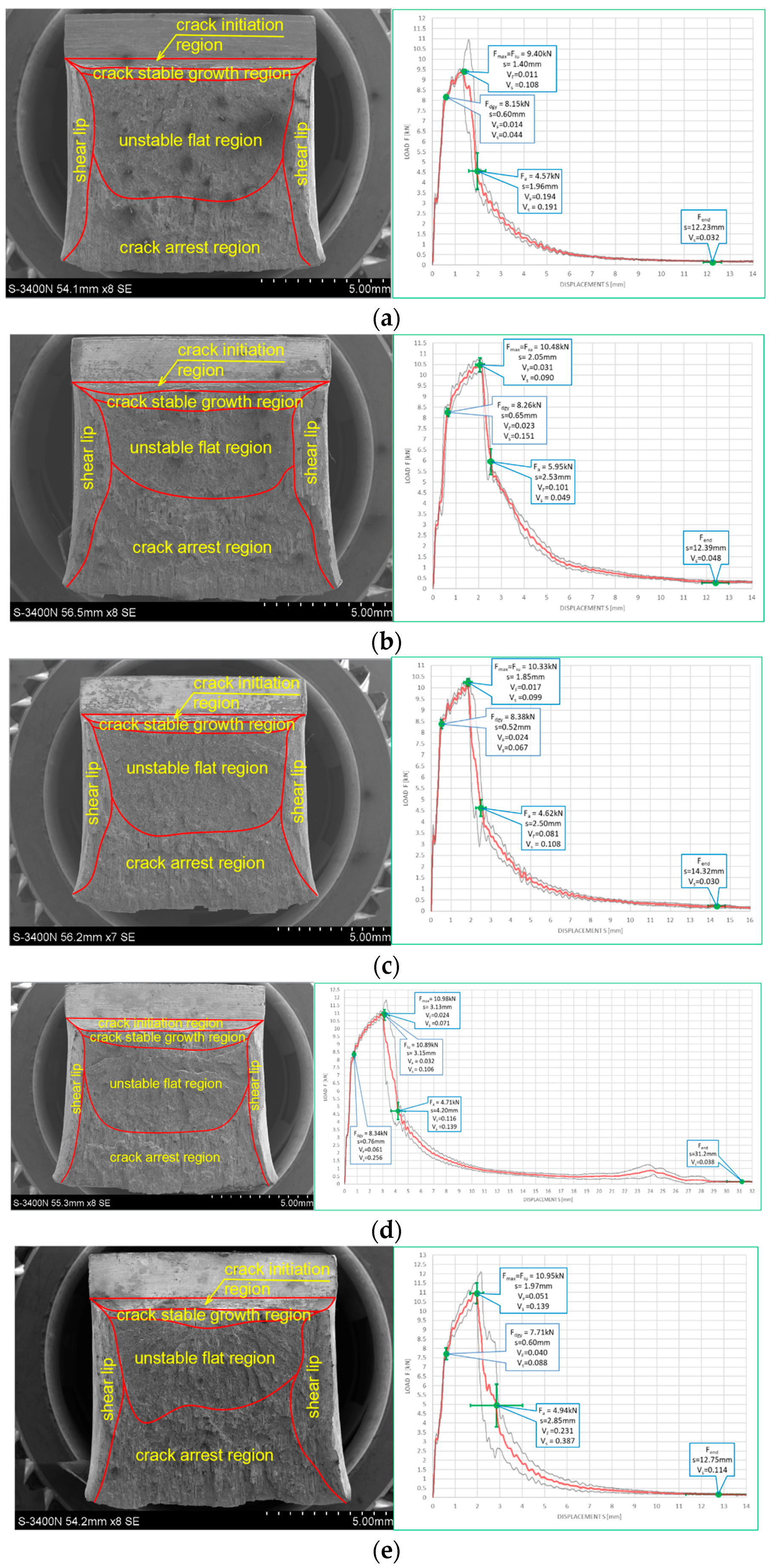

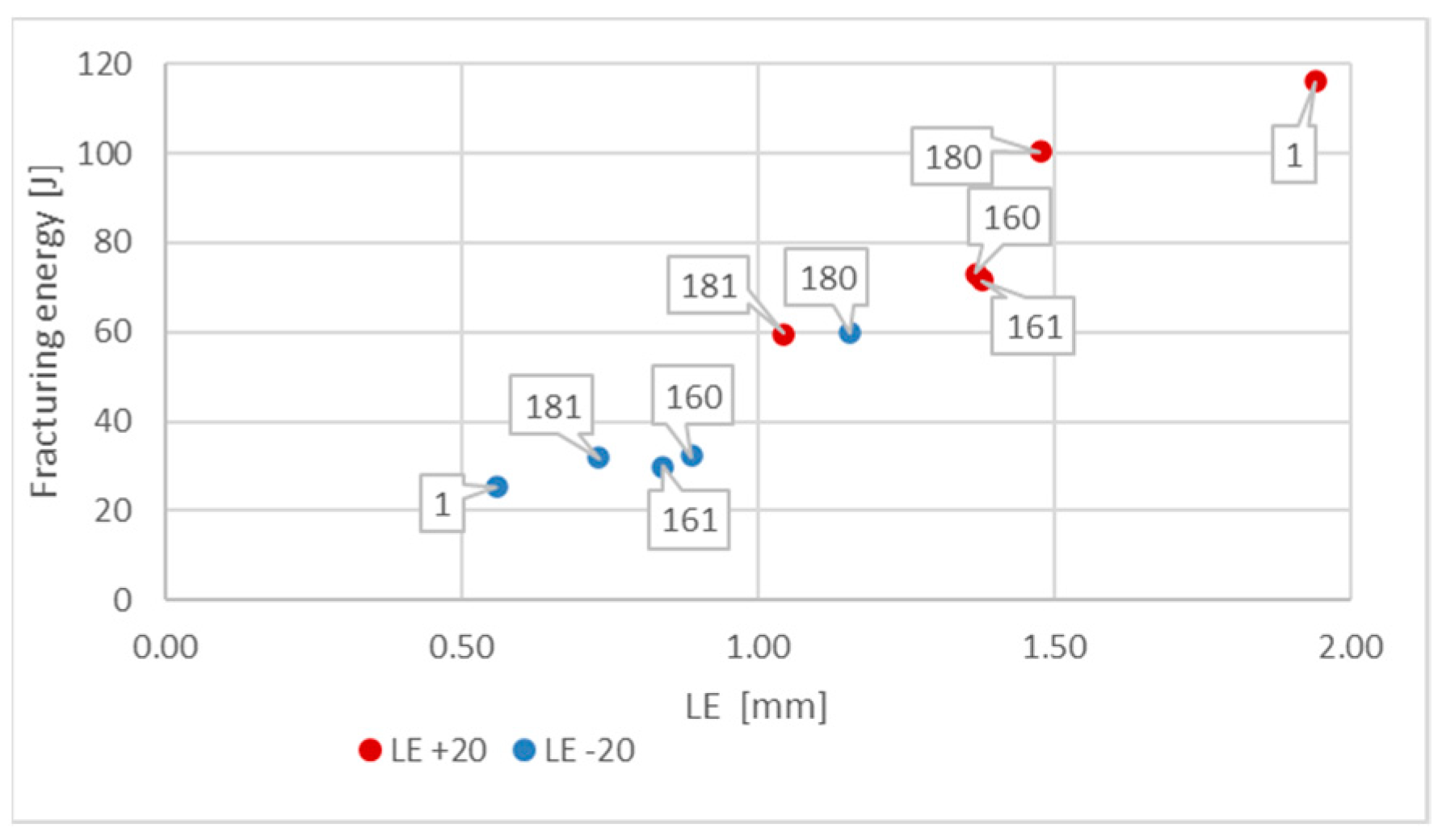
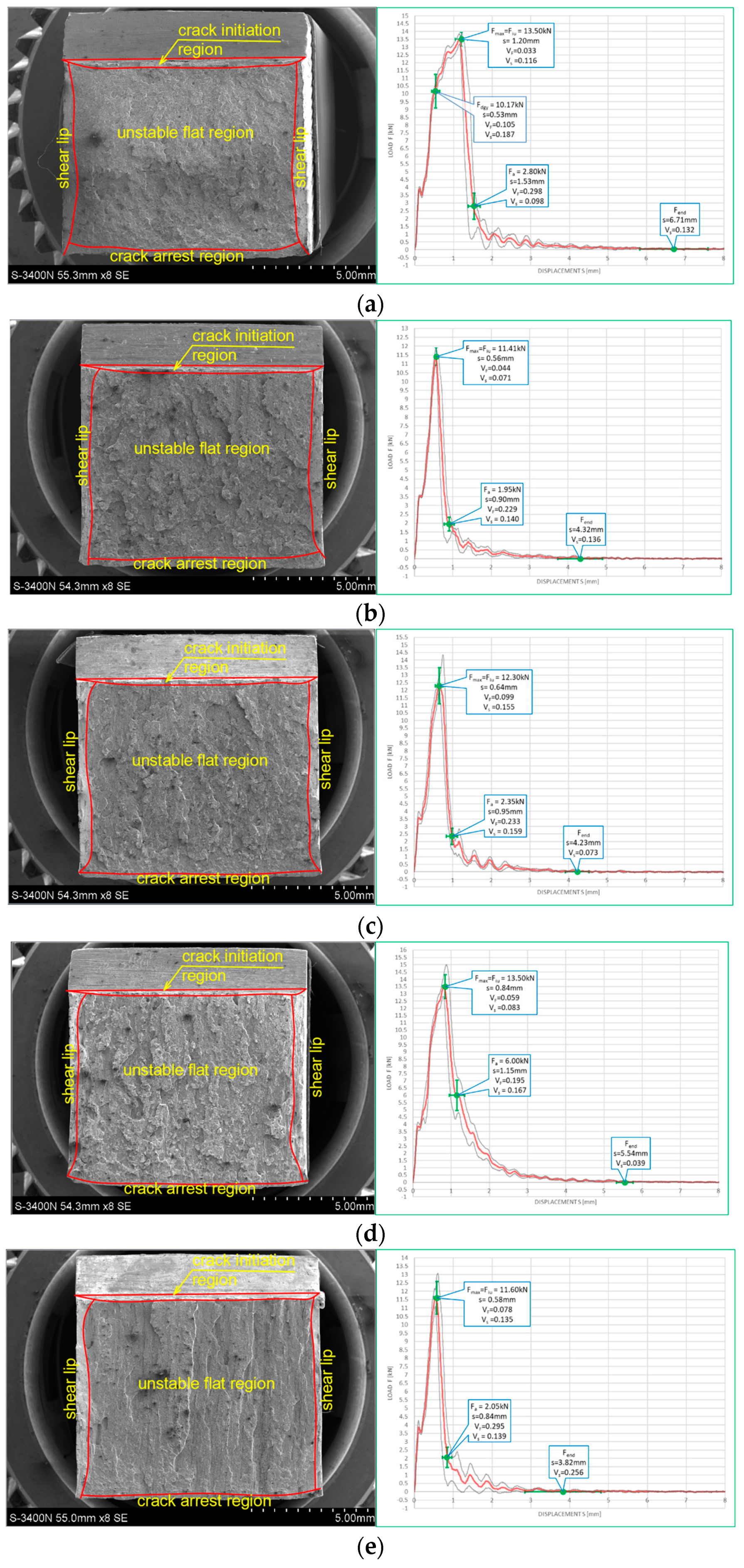
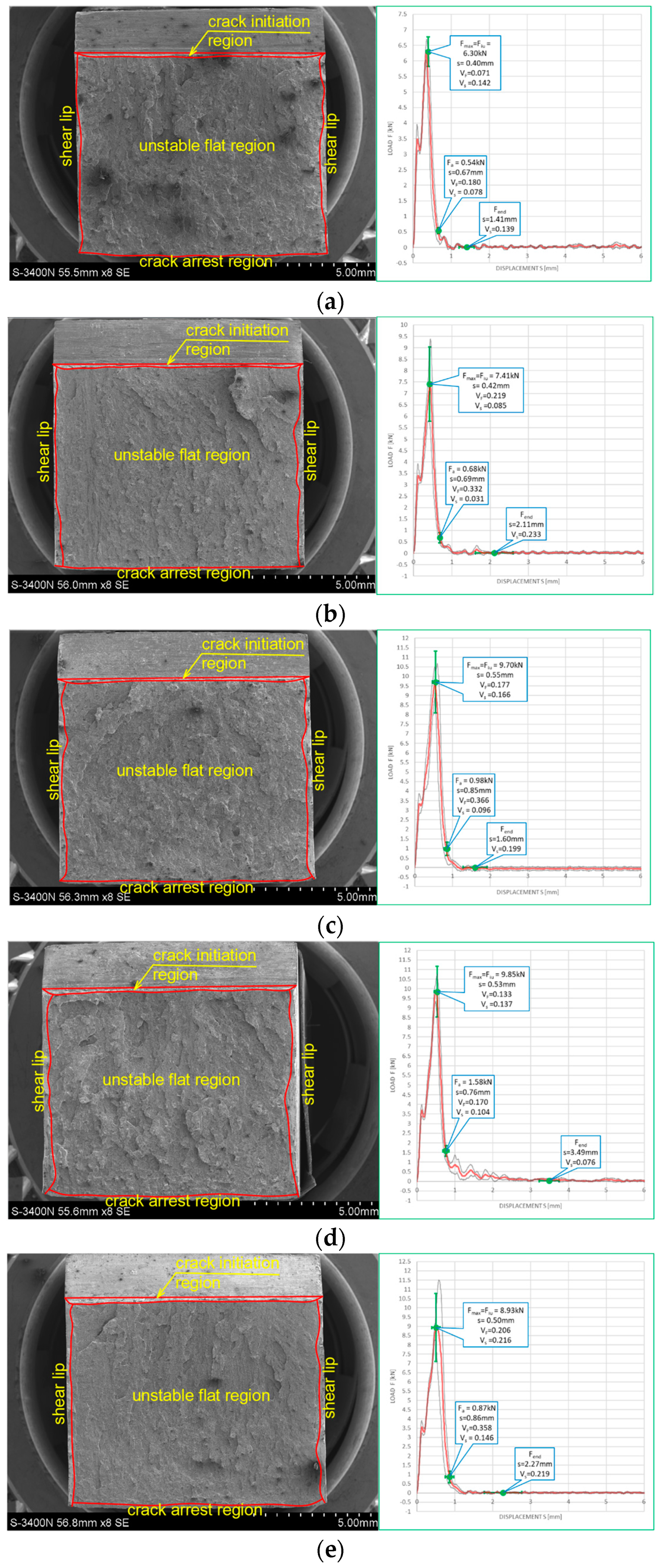
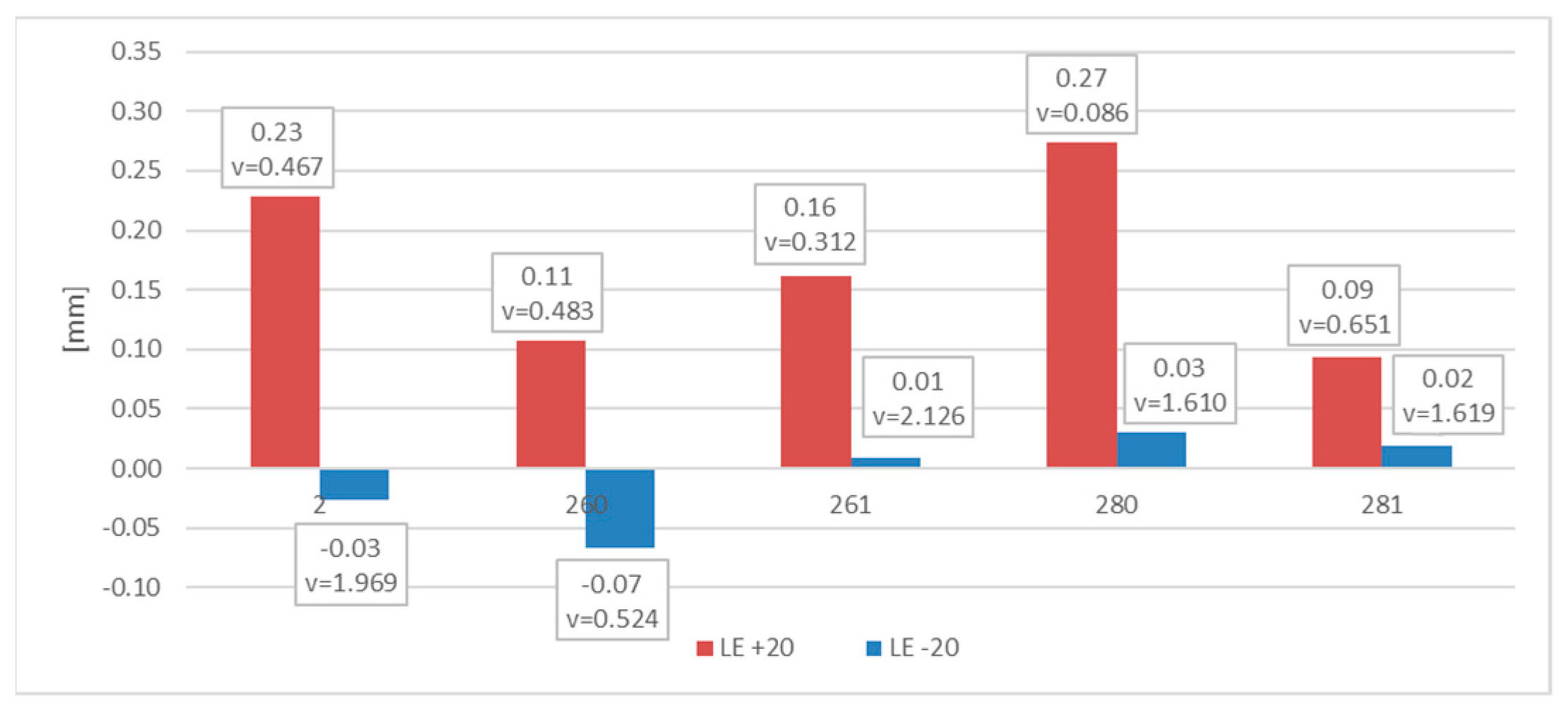
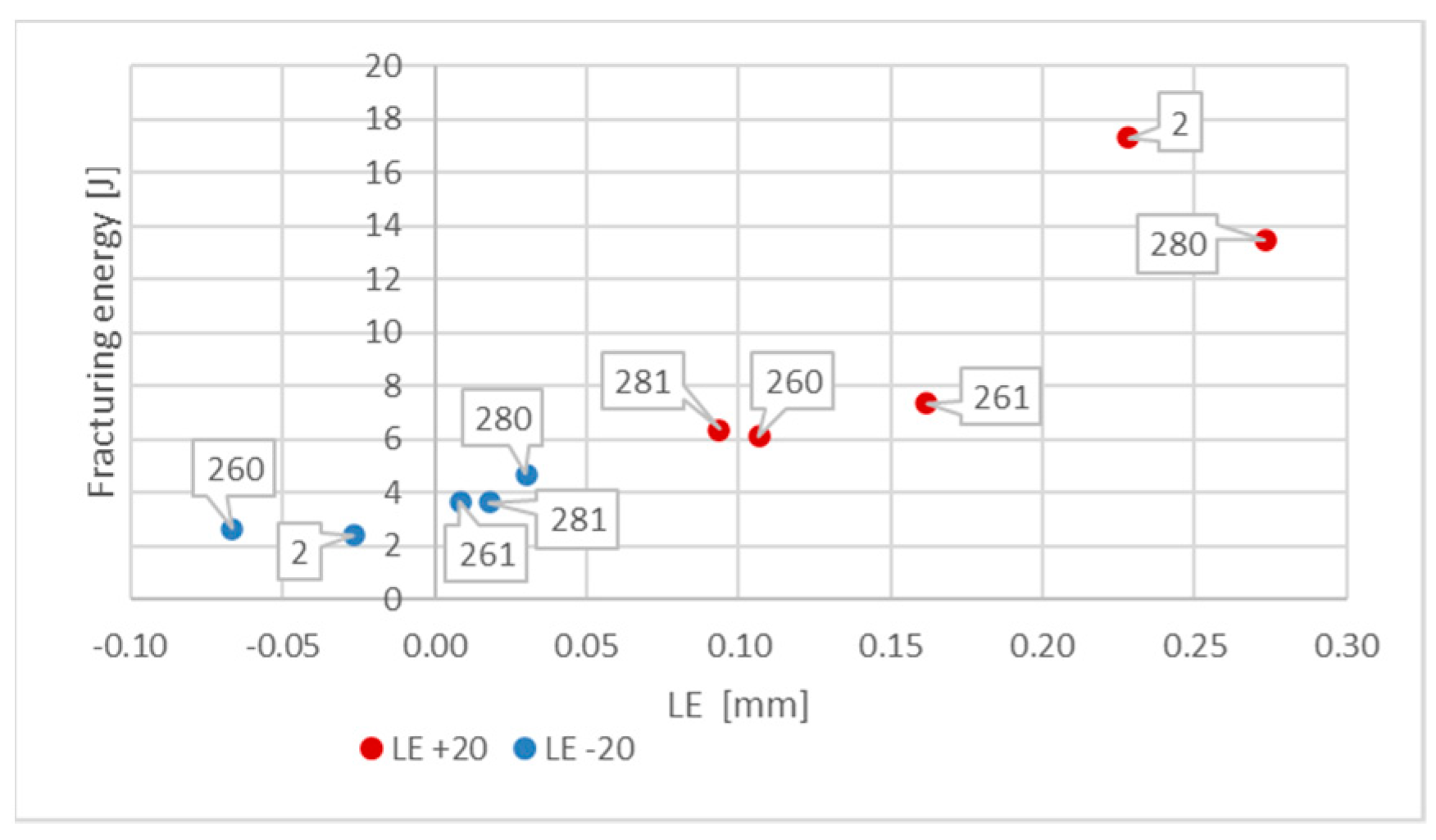


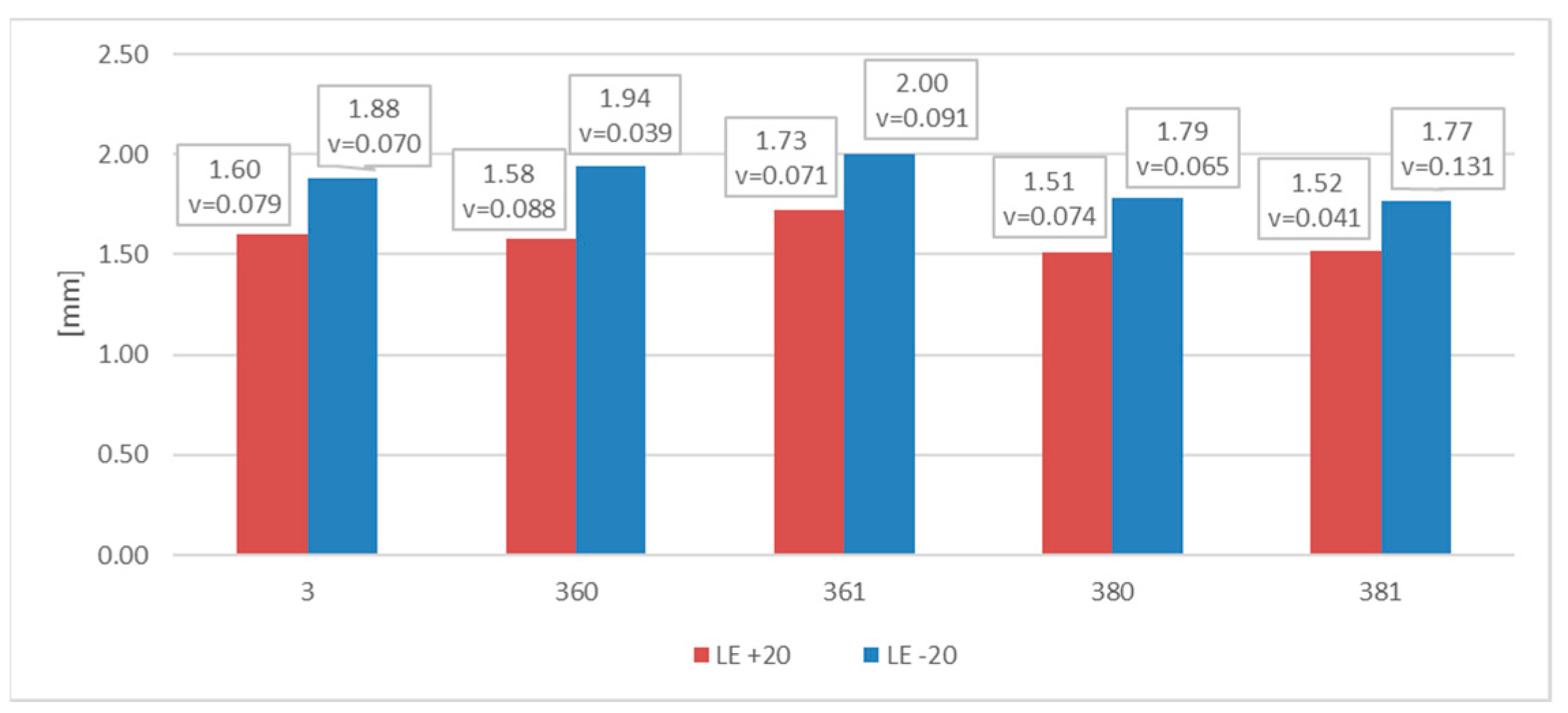




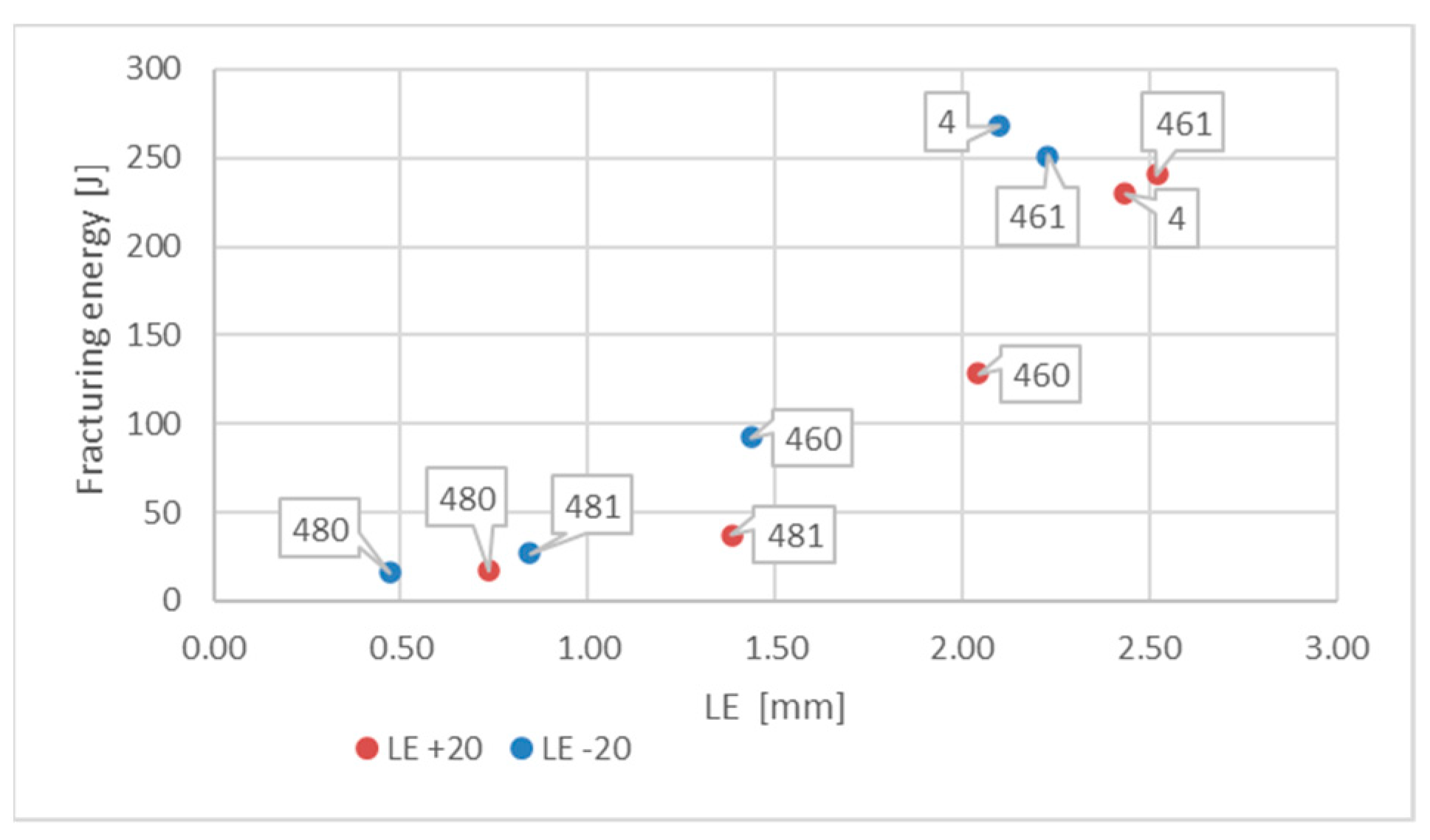
| First Digit—Steel Grade | Second Digit—Heating Temperature | Third Digit—Cooling Mode | Additional Information—Testing Temperature |
|---|---|---|---|
| 1—S355J2+N 2—X20Cr13 3—X6CrNiTi18-10 4—X2CrNiMoN22-5-3 | 6—600 °C 8—800 °C | 0—slow cooling in the furnace 1—fast cooling in water mist | (+20)—+20 °C (−20)—–20 °C |
| Element | C | Si | Mn | P | S | Cr | Ni | Mo |
| Content by wt. % | 0.185 | 0.164 | 1.44 | 0.0066 | 0.003 | 0.0298 | <0.005 | <0.005 |
| Element | Ti | Cu | Al | Co | Nb | V | W | |
| Content by wt. % | <0.002 | 0.0861 | 0.0349 | 0.0032 | <0.002 | <0.002 | <0.015 |
| Sample Number | Temperature of Test (°C) | SFA(1) (%) | SFA(2) (%) | SFA(3) (%) | SFA(4) (%) | SFA(5) (%) | ||||
|---|---|---|---|---|---|---|---|---|---|---|
| Average | Standard Deviation | Average | Standard Deviation | Average | Standard Deviation | Average | Standard Deviation | |||
| 1 | +20 | 100 | 100 | 100 | 100 | 100 | ||||
| −20 | 47.07 | 8.21 | 54.90 | 7.22 | 51.30 | 7.68 | 69.25 | 6.11 | 50 | |
| 160 | +20 | 100 | 100 | 100 | 100 | 100 | ||||
| −20 | 55.95 | 5.90 | 63.20 | 4.68 | 59.91 | 5.15 | 75.55 | 3.77 | 65 | |
| 161 | +20 | 100 | 100 | 100 | 100 | 100 | ||||
| −20 | 46.45 | 4.65 | 54.20 | 3.54 | 50.64 | 3.97 | 68.99 | 3.27 | 52 | |
| 180 | +20 | 100 | 100 | 100 | 100 | 100 | ||||
| −20 | 43.85 | 5.90 | 54.61 | 5.87 | 49.81 | 5.93 | 67.23 | 4.38 | 52 | |
| 181 | +20 | 91.62 | 18.74 | 93.17 | 15.28 | 92.47 | 16.83 | 95.27 | 10.57 | 100 |
| −20 | 44.50 | 7.97 | 57.27 | 6.22 | 51.72 | 6.98 | 68.15 | 5.74 | 60 | |
| Element | C | Si | Mn | P | S | Cr | Ni | Mo |
| Content by wt. % | 0.247 | 0.428 | 0.784 | 0.0153 | 0.0166 | 13 | 0.1 | 0.146 |
| Element | Ti | Cu | Al | Co | Nb | V | W | |
| Content by wt. % | 0.0045 | 0.0479 | 0.0086 | 0.0132 | <0.002 | 0.009 | <0.02 |
| Sample Number | Temperature of Test (°C) | SFA(1) (%) | SFA(2) (%) | SFA(3) (%) | SFA(4) (%) | SFA(5) (%) | ||||
|---|---|---|---|---|---|---|---|---|---|---|
| Average | Standard Deviation | Average | Standard Deviation | Average | Standard Deviation | Average | Standard Deviation | |||
| 2 | +20 | 20.19 | 5.70 | 36.71 | 5.55 | 29.44 | 5.51 | 46.98 | 6.12 | 11 |
| −20 | 7.95 | 1.28 | 7.95 | 1.28 | 7.95 | 1.28 | 28.09 | 2.39 | 0 | |
| 260 | +20 | 14.54 | 3.20 | 14.54 | 3.20 | 14.54 | 3.20 | 37.87 | 4.39 | 11 |
| −20 | 8.92 | 1.37 | 8.92 | 1.37 | 8.92 | 1.37 | 29.77 | 2.31 | 0 | |
| 261 | +20 | 19.69 | 4.79 | 19.69 | 4.79 | 19.69 | 4.79 | 43.99 | 5.81 | 6 |
| −20 | 10.54 | 2.86 | 10.54 | 2.86 | 10.54 | 2.86 | 32.19 | 4.20 | 0 | |
| 280 | +20 | 38.99 | 9.06 | 38.99 | 9.06 | 38.99 | 9.06 | 62.04 | 7.08 | 6 |
| −20 | 16.33 | 3.68 | 16.33 | 3.68 | 16.33 | 3.68 | 40.16 | 4.53 | 0 | |
| 281 | +20 | 16.19 | 3.92 | 16.19 | 3.92 | 16.19 | 3.92 | 39.97 | 4.54 | 6 |
| −20 | 9.62 | 2.58 | 9.62 | 2.58 | 9.62 | 2.58 | 30.72 | 4.27 | 0 | |
| Element | C | Si | Mn | P | S | Cr | Ni | Mo |
| Content by wt. % | 0.0709 | 0.467 | 1.84 | 0.0246 | <0.005 | 18 | 9.12 | 0.347 |
| Element | Ti | Cu | Al | Co | Nb | V | W | |
| Content by wt. % | 0.352 | 0.261 | 0.0356 | 0.00983 | 0.0167 | <0.087 | <0.02 |
| Sample Number | Temperature of Test (°C) | SFA(1) (%) | SFA(2) (%) | SFA(3) (%) | SFA(4) (%) | SFA(5) (%) | ||||
|---|---|---|---|---|---|---|---|---|---|---|
| Average | Standard Deviation | Average | Standard Deviation | Average | Standard Deviation | Average | Standard Deviation | |||
| 3 | +20 | 100 | 100 | 100 | 100 | 100 | ||||
| −20 | 100 | 100 | 100 | 100 | 100 | |||||
| 360 | +20 | 100 | 100 | 100 | 100 | 100 | ||||
| −20 | 100 | 100 | 100 | 100 | 100 | |||||
| 361 | +20 | 100 | 100 | 100 | 100 | 100 | ||||
| −20 | 100 | 100 | 100 | 100 | 100 | |||||
| 380 | +20 | 100 | 100 | 100 | 100 | 100 | ||||
| −20 | 100 | 100 | 100 | 100 | 100 | |||||
| 381 | +20 | 100 | 100 | 100 | 100 | 100 | ||||
| −20 | 100 | 100 | 100 | 100 | 100 | |||||
| Element | C | Si | Mn | P | S | Cr | Ni | Mo |
| Content by wt. % | 0.0507 | 0.266 | 1.8 | 0.027 | <0.005 | 23.7 | 4.74 | 2.92 |
| Element | Ti | Cu | Al | Co | Nb | V | W | |
| Content by wt. % | 0.0082 | 0.184 | 0.0097 | 0.0622 | 0.0056 | 0.0385 | <0.02 |
| Sample Number | Temperature of Test (°C) | SFA(1) (%) | SFA(2) (%) | SFA(3) (%) | SFA(4) (%) | SFA(5) (%) | ||||
|---|---|---|---|---|---|---|---|---|---|---|
| Average | Standard Deviation | Average | Standard Deviation | Average | Standard Deviation | Average | Standard Deviation | |||
| 4 | +20 | 100 | 100 | 100 | 100 | 100 | ||||
| −20 | 100 | 100 | 100 | 100 | 100 | |||||
| 460 | +20 | 100 | 100 | 100 | 100 | 100 | ||||
| −20 | 100 | 100 | 100 | 100 | 100 | |||||
| 461 | +20 | 100 | 100 | 100 | 100 | 100 | ||||
| −20 | 100 | 100 | 100 | 100 | 100 | |||||
| 480 | +20 | 100 | 100 | 100 | 100 | 100 | ||||
| −20 | 100 | 100 | 100 | 100 | 100 | |||||
| 481 | +20 | 100 | 100 | 100 | 100 | 100 | ||||
| −20 | 100 | 100 | 100 | 100 | 100 | |||||
Disclaimer/Publisher’s Note: The statements, opinions and data contained in all publications are solely those of the individual author(s) and contributor(s) and not of MDPI and/or the editor(s). MDPI and/or the editor(s) disclaim responsibility for any injury to people or property resulting from any ideas, methods, instructions or products referred to in the content. |
© 2023 by the authors. Licensee MDPI, Basel, Switzerland. This article is an open access article distributed under the terms and conditions of the Creative Commons Attribution (CC BY) license (https://creativecommons.org/licenses/by/4.0/).
Share and Cite
Maslak, M.; Pazdanowski, M.; Stankiewicz, M.; Wassilkowska, A.; Zajdel, P.; Zielina, M. Impact Fracture Surfaces as the Indicators of Structural Steel Post-Fire Susceptibility to Brittle Cracking. Materials 2023, 16, 3281. https://doi.org/10.3390/ma16083281
Maslak M, Pazdanowski M, Stankiewicz M, Wassilkowska A, Zajdel P, Zielina M. Impact Fracture Surfaces as the Indicators of Structural Steel Post-Fire Susceptibility to Brittle Cracking. Materials. 2023; 16(8):3281. https://doi.org/10.3390/ma16083281
Chicago/Turabian StyleMaslak, Mariusz, Michal Pazdanowski, Marek Stankiewicz, Anna Wassilkowska, Paulina Zajdel, and Michal Zielina. 2023. "Impact Fracture Surfaces as the Indicators of Structural Steel Post-Fire Susceptibility to Brittle Cracking" Materials 16, no. 8: 3281. https://doi.org/10.3390/ma16083281
APA StyleMaslak, M., Pazdanowski, M., Stankiewicz, M., Wassilkowska, A., Zajdel, P., & Zielina, M. (2023). Impact Fracture Surfaces as the Indicators of Structural Steel Post-Fire Susceptibility to Brittle Cracking. Materials, 16(8), 3281. https://doi.org/10.3390/ma16083281







